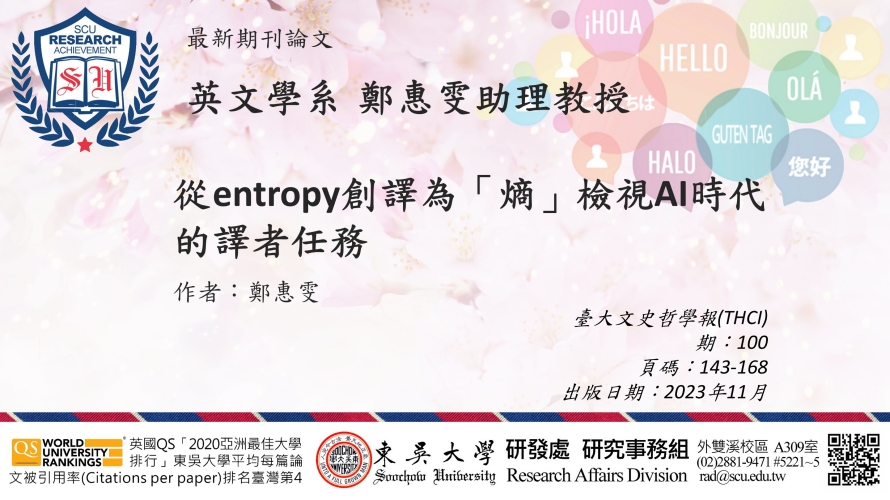【研究發展處訊】
英文學系鄭惠雯助理教授發表最新期刊論文
從entropy創譯為「熵」檢視AI時代的譯者任務
The Task of the Translator in the Age of Artificial Intelligence: A Case Study of the Translation of “Entropy” into the Chinese Character “Shang”
作者:鄭惠雯(Cheng, Hui-wen)
臺大文史哲學報(THCI)
期:100
頁碼:143-168
出版日期:2023年11月
中文摘要
Entropy一詞最初用以表示熱量改變程度的值,而後亦用於描述封閉系統的混亂程度。據傳此概念於1920年代傳入中國,最早譯為「熵」。本研究的初始提問為譯者為何使用「熵」字來對應entropy?譯者的創譯/創意從何而來?是否為譯者以「火」作為部首,加上「商」字而創造的新字?或是早已存在的冷僻字,因翻譯之故被賦予新義?其本義為何?此外,「熵」字的出現是否與晚清科學名詞單一漢字的翻譯原則有關?故本研究從entropy的字源探討開始,接著查考「熵」的字音與字義,推敲entropy中譯為「熵」的歷史。最後,根據此中譯過程揭示之譯者的創發能力,嘗試從史蒂格勒的「負熵」概念論述AI時代的自動化翻譯如何影響語言與譯者,由此反思班雅民的譯者任務。
英文摘要
"Entropy" was a term first coined to indicate the transformation of thermal energy and was later adopted to describe the degree of disorder of a closed system. It is said that the concept was introduced into China in the 1920s and was first translated as shang. Hence, the initial question of this study revolves around how such translational equivalence was made. How was the translation/transcreation formed by the translator? Was the Chinese character coined by the translator through combining the radical huo, meaning "fire," with the root shang, meaning "quotient?" Or, was it a long existent but rare character rediscovered and redefined by the translator? What was its original meaning? In addition, was the choice of a single character shang made under the influence of various translation projects of Western scientific terms launched during the late Qing dynasty? Therefore, the present study takes the translation of the term "entropy" as a point of departure, and explores the pronunciation and definition of shang as well as the history of how it becomes the Chinese counterpart of "entropy." The process of English-to-Chinese translation of "entropy" exhibits prominently the translator's originality and innovation. For contemporary relevance, Bernard Stiegler's notion of negentropy is employed to address the important questions of how AI automatic translation may pose impact on human language and the translator; accordingly, the paper offers substantial insights into the task of the translator defined by Walter Benjamin.
研究事務組提醒:教師如有最新發表於AHCI、SSCI、SCI、EI、TSSCI、THCI、「東吳大學外語學門獎勵名單」之期刊論文,歡迎將相關資訊e-mail至agnes@scu.edu.tw,研究發展處將會公告於校園頭條,以廣交流。
【文圖/研究事務組謝明秀專員】
